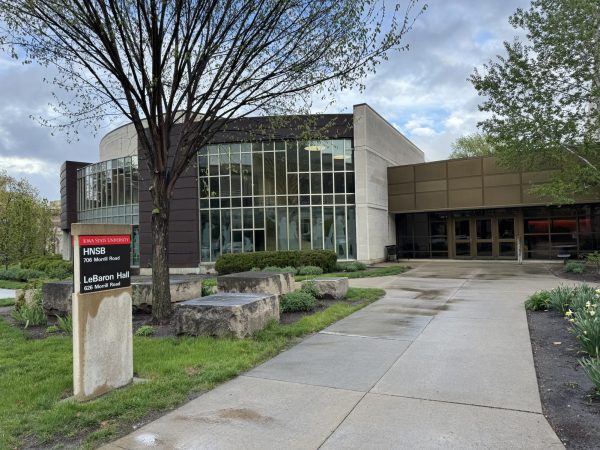Spots on Apples, the devastation of Sooty Blotch and Flyspeck
September 20, 2011
Spots, specks, blotches. Cosmetic impurities like these are commonly not wanted on produce such as apples. However, there is a disease that orchard farmers deal with that causes those outside blemishes.
The flyspeck and sooty blotch disease caused by a fungi complex is one of the culprits behind the dark spots, smudges and other blemishes on apples. Flyspeck and sooty blotch don’t just affect apples either. They can appear on other plants and fruits like wild plums, Asian pears, grapes and more.
“Diseases affect how much the apples cost and also what quality they are,” said Mark Gleason, professor of plant pathology and microbiology. “If you eat plants, you should be interested in plant diseases.”
Flyspeck and sooty blotch were once thought of as being caused by two separate fungi. For about 80 years, this thought was the dominant theory. However, the thought today is that flyspeck and sooty blotch are both caused by the same fungi and that this fungi has many different variations. There are at least 60 different variations of this fungus.
“It doesn’t help our understanding to think of sooty blotch and flyspeck as two diseases,” Gleason said. “What we have is a complex that varies regionally, and probably varies around the world.”
The devastation of the disease can be hard to tell. Sooty blotch and flyspeck spreads from one plant to another using the weather. The spores travel with the help of rain and the wind. When it’s on the plant, if there’s dew, the dew helps the fungus grow.
“It depends on the year. If we have wet summers, we will have more sooty blotch and flyspeck,” Gleason said.
The spores also can spend winter in mummified fruit as well, spreading during spring.
The department of pathology and microbiology, along with researching the different strains, is developing a new warning system to help combat the disease. The old one measured leaf wetness (the time the leaves and apples were wet), which was an issue because it was not something everyone measured. The new warning system, still in development, is based on relative humidity, which is more commonly measured.
Farmers can protect their orchards in a few ways. The first, most used method is by using fungicides. The amount of times that farmers must spray vary each year, depending on how wet it is. The wetter the growing season, the more often farmers have to spray. Typically, farmers spray about once a week in spring. But starting in late May and throughout summer, they spray more frequently.
Both older fungicides and newer fungicides are used in protecting against sooty blotch and flyspeck. Unlike the older fungicides, the newer fungicides have less health hazards, but newer fungicides aren’t as durable as the older ones. The fungi also can develop resistance against these newer fungicides. By using the new warning system, researchers hope the amount of fungicide sprayed can be lessened, because it can tell the farmer when to spray.
A second method is to prune the trees during winter. By pruning, there is better air circulation through the tree. With more air circulation, the tree doesn’t spend as much time drying, so there is less time the fungus is exposed to wetness, allowing the fungus to grow and spread. The area around the orchard matters as well, for the plants around the orchard could be carriers of sooty blotch and flyspeck.
“The trees near windbreaks have more than those not,” said Derrick Mayfield, graduate student in plant pathology and microbiology.
Sooty blotch and flyspeck doesn’t actually harm the apple or the tree, unlike other apple diseases like fireblight, which is caused by bacteria or apple scab. The disease only affects the outer level, the skin of the apple. And it does not harm people’s health either.
“It’s pretty harmless, it doesn’t taste like anything. It doesn’t produce mycotoxins. If you eat a fungus that can kill you, it’s because it has mycotoxins,” Mayfield said.
“It’s not bad to your health unless you have an allergy,” Gleason said.
Just because it does not affect people’s health does not mean it does not affect people, though.
The people who grow apples, other plants or fruits whose crops are infected are affected. People don’t want apples with blemishes or spots.
“It’s devastating if you’re the grower. You can only use the apples for juice or in pies if you have it, because no one wants it,” Gleason said.
“People know what a good apple looks like. They’re used to the Disney World-looking apples. People don’t want apples with smudges on it,” Mayfield said.
















